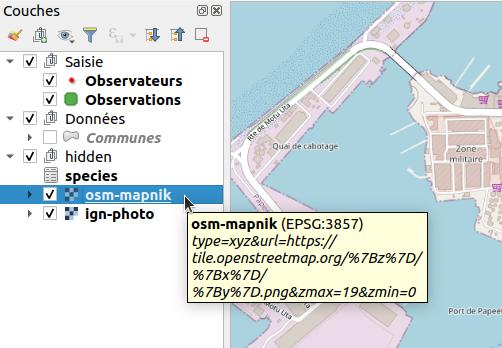Printing
Extent defined by the user on the fly in Lizmap
To add print capabilities in the online map, you have to create at least one print layout without atlas enabled. Then you will find the list of your layouts in the Layouts plugin tab. They are enabled by default but you can disable it or set permissions for groups.
Note
Printing will respect the feature filters and selections.
Creating the layout
In your layout, you can add :
A map, without an atlas enabled
An image to North arrow
An image for the logo of your organization
A legend that will be fixed for all printing
Labels
- A scale
Either Numeric
Or set Fit segment width with a correct reference anchor point to adjust the position of the scale bar
A location map, a map for which you have enabled and configured the function of Overview, read Create an overview map
Since QGIS 3, you can use QGIS expressions, in your labels for instance. You can create automatic source label according to visible layers following this example on the QGIS documentation.
Dynamic content
You can allow the user to modify the contents of certain labels (title, description, comment, etc). To do this, you need to add an identifier to your label in the layout.
Warning
Each identifier must be unique for the whole layout. Identifiers must be strings, without integers or spaces
(e.g. it must be custom_title, nor 1 neither custom title).

Lizmap will automatically ask the user in the web-browser to fill each fields.
Tip
If your label is pre-populated in QGIS, the field will be pre-populated too in the web-browser.
If you check ‘Render as HTML’ for your label in QGIS, you will have a multiline label in Lizmap accepting HTML code. But you will need to
<br>for line breaks.
The preview in Lizmap will be similar to this screenshot. The light rectangle is the area the user can define in the web browser. The user can also set the map description and title.

Scales
The print function will be based on the map scales that you set in the plugin Map (Map options — The general options of the map).
Layout with an atlas when using a popup
Read in the popup chapter, Link to a PDF layout using the QGIS Atlas
Allow printing of external baselayers
Warning
This section is now deprecated. You should use the baselayers group provided by the plugin.
The Lizmap plugin Baselayers tab allows you to select and add external baselayers (Base layers — Layers used for the background of the map). These external baselayers are not part of the QGIS project, default print function does not integrate them.
To overcome this lack Lizmap offers an easy way to print a group or layer instead of the external baselayer. To be able to print a layer which is visible in Lizmap Web Client only:
You need to add the equivalent layer in the QGIS project.
You need to hide it from the Lizmap legend, see Masking individual layers.
Rename the layer to one of these names:
osm-mapnikfor OpenStreetMaposm-stamen-tonerfor OSM Stamen Tonerosm-cyclemapfor OSM CycleMapopen-topo-mapfor OpenTopoMapgoogle-satellitefor Google Satellitegoogle-hybridfor Google Hybridgoogle-terrainfor Google Terraingoogle-streetfor Google Streetsbing-roadfor Bing Roadbing-aerialfor Bing Aerialbing-hybridfor Bing Hybridign-scanfor IGN Scanign-planfor IGN Planign-photofor IGN Photosign-cadastralfor IGN Cadastre

In the screenshot above, we can notice the `osm-mapnik` layer in the `hidden` group, which is a TMS layer using https://tiles.openstreetmap.org.
Note
The use of this method must be in compliance with the licensing of external baselayers used (Base layers — Layers used for the background of the map).
Warning
If it’s not working, check that your server is able to access to the internet. These base layers are provided
online only.
Some proxy or firewalls might block some requests to the internet. If your server is behind a proxy, check that
QGIS Server is configured with the proxy settings (using the file QGIS3.ini and the section [proxy]).
Refer to the QGIS Server documentation for these settings.
To add these layers, you can use existing WMS/WMTS services, XYZ providers (with QuickMapServices), local files…
For IGN baselayers, you can use IGN’s WMS or WMTS url. The key used for this url need to be protected by referer and IP.
In referer, you have to indicate your projects page’s URL like this : .*your-url.fr.*. In IP, you have to indicate
your Lizmap server’s IP and your computer’s IP (to open IGN’s WMS url in QGIS on your computer). Both IP addresses must
be separated by a comma. Beware, if you use IGN WMS or WMTS layers, QGIS project’s EPSG code should be 3857.
Adding your own images in a layout
If you add some custom images in a layout, such as custom North arrow or your organization logo, the server needs to access these images too.
Either use an image with an URL
http://so that your image is accessible on both your local computer and on the server.Or use QGIS expression to build a compatible path on both desktop and server (it should work out of the box, but in case it’s not working, you can use an expression.) :
Put your images in the
mediadirectory (see Media), this is not mandatory, you can put it next to your project file.Use an QGIS expression
@project_home || '/media/organization_logo.png'.Use slash even if you are on Windows.
